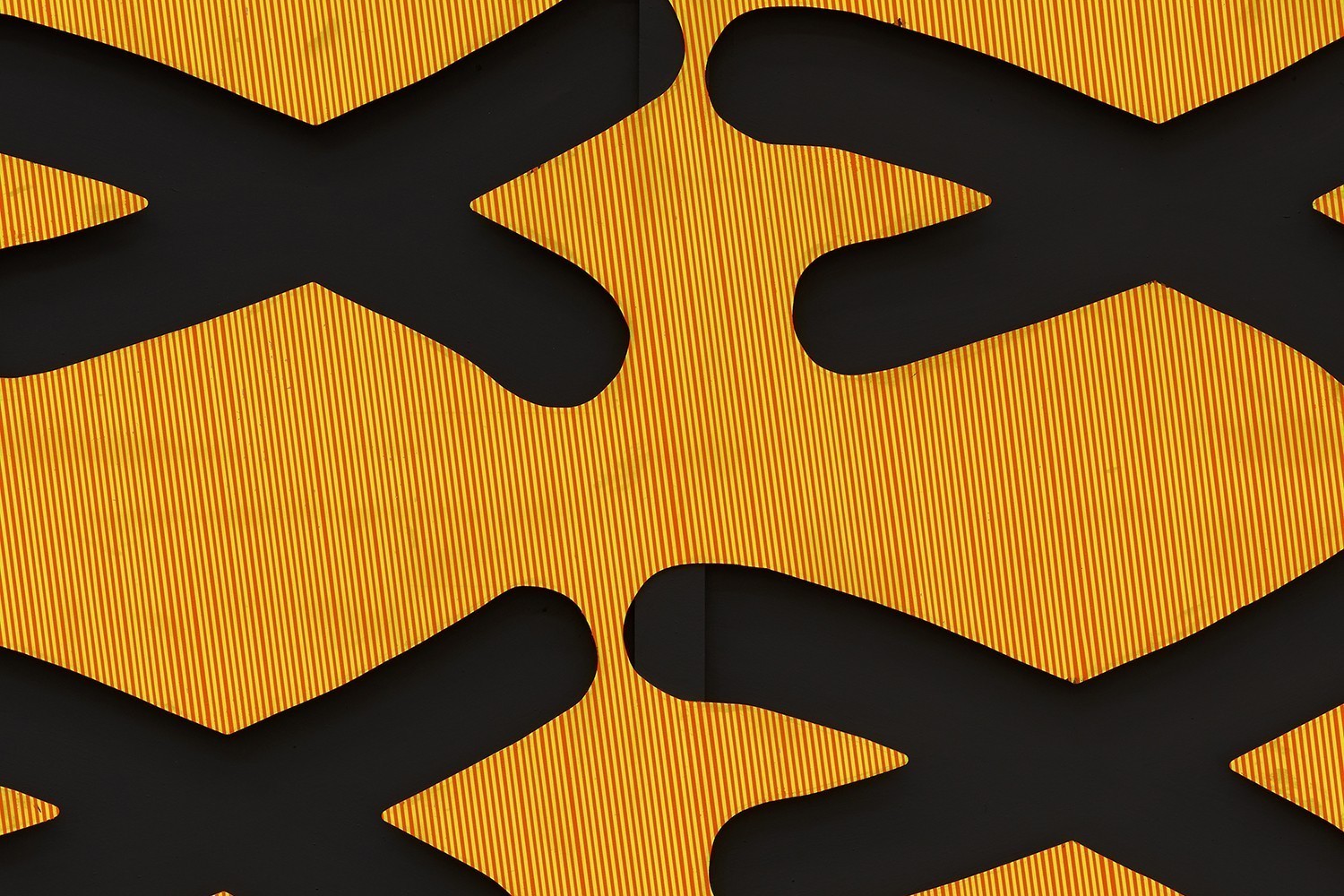Jonas Maas
Chanala
November 4, 2023 – January 20, 2024
Jonas Maas

Biography
Jonas Maas (*1985 in Trier, lebt in Düsseldorf) studierte von 2006 bis 2010 an der Kunsthochschule Mainz in der Klasse von Winfried Virnich, wechselte an die Kunstakademie Düsseldorf und schloss dort 2014 sein Studium als Schüler von Tomma Abts ab. 2009 war er Stipendiat der Studienstiftung des deutschen Volkes, 2016 Stipendiat der Lepsien Art Foundation, Düsseldorf, und 2018 lebte er mit einem NRW Residenzstipendium auf Schloss Ringenberg in Hamminkeln.
Während die klassische Idee des Malens durch das händische Auftragen von flüssiger Farbe auf eine meist rechteckig begrenzte Fläche definiert wird, erweitert Jonas Maas auf radikale Weise das Spektrum der Möglichkeiten dessen, was unter dem Begriff „Malerei“ subsumiert werden kann. Er dekonstruiert das traditionelle Verhältnis von Bildträger und Bild, von flächigem Malgrund und Farbmaterial, indem er Träger, Farbe und Formen als gleichberechtigte Elemente eines Bildes der Malerei agieren lässt – als systemische Fragmentierung und fragmentarische Systematisierung zugleich.
In dieser operativen Analyse durchsetzen beispielsweise Löcher und lochhafte Öffnungen den Träger und zeigen die Wand als integrales Bildelement. Oder gitterartige Konstruktionen übernehmen den Part des Rahmens und werden als Teil des Bildes zum koinzidenten Indikator von Räumlichkeit und Flächigkeit. In anderen Werken kontrapunktieren aus der planen Fläche geknickte Platten die raumillusionistische Wirkung des mit Rastern versehenen farbig gefassten Formates.
Maas setzt bei seinen Werken auf unkonventionelle Techniken: so arbeitet er auf Holz und Aluminium, nicht auf Leinwand. Auf seine Malgründe, die oft mit gestisch aufgetragenem Kreidegrund grundiert sind (und so klassische Malereibewegungen suggerieren), druckt er oft im UV-Druckverfahren Kompositionen, die in Bildverarbeitungsprogrammen am Computer entstanden sind; ansonsten trägt er die Farbe, abgesehen vom klassischen Pinsel, mit der Rolle oder dem Spachtel auf.
Maas, so kann man es zusammenfassen, untersucht mit den Mitteln von Schematisierung und Störung, von visueller Überforderung und minimalistischer Reduktion, konkreten Verhältnissen und diffusen Zwischenräumen bzw. Leerstellen die Bedingungen und Möglichkeiten von spezifisch farbigen Strukturen im Raum.
Jonas Maas (*1985 in Trier, lives in Düsseldorf) studied at the Kunsthochschule Mainz in the class of Winfried Virnich from 2006 to 2010. In 2010 he moved to the Kunstakademie Düsseldorf and graduated there in 2014 as a student of Tomma Abts. In 2009 he was a fellow of the Studienstiftung des deutschen Volkes, in 2016 a fellow of the Lepsien Art Foundation, Düsseldorf, and in 2018 he lived at Schloss Ringenberg in Hamminkeln on a NRW residency grant.
While the traditional idea of painting is defined by the manual application of liquid paint on a mostly rectangular surface, Jonas Maas radically expands the spectrum of possibilities of what can be subsumed under the term “painting.” He deconstructs the traditional relationship between image carrier and image, between flat painting ground and color material, by allowing carrier, color, and forms to act as equal elements of an idea of painting – as systemic fragmentation and fragmentary systematization at the same time.
In this operative analysis, holes and hole-like openings, for example, penetrate the support and reveal the wall as an integral pictorial element. Or grid-like constructions take over the part of the frame and, as part of the picture, become a coincident indicator of spatiality and flatness. In other works panels bent out of the flat surface counterpoint the spatial illusionist effect of the color-framed format provided with grids.
Maas relies on unconventional techniques in his works: for example, he works on wood and aluminum, not on canvas. On his painting surfaces, which are often primed with gesturally applied chalk ground (thus suggesting traditional painting movements), he often prints compositions, using the UV printing process, which were created in image processing programs on the computer; otherwise, apart from the classic brush, he applies the paint with a roller or palette knife.
It can be summarized that Maas uses the means of schematization and disruption, of visual overload and minimalist reduction, specific relationships and diffuse interstices or voids to investigate the conditions and possibilities of specifically colored structures in space.
Texts
A selection of texts and essays on the artists for download.
Exhibitions
Chanala
November 4, 2023 – January 20, 2024
April 22 – May 27, 2023
spectre
November 9, 2019 – January 18, 2020
Der Raum der Malerei
May 25 – August 31, 2019
Y
September 5 – November 7, 2015
Plural
May 3 – June 21, 2014
cluster
April 20 – June 15, 2013